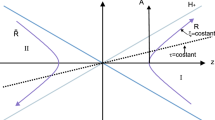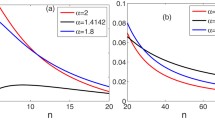Abstract
We study the entanglement of a pentapartite W-class state system in the noninertial frame when transformed from the Minkowski coordinates to Rindler space. Five different cases are considered, one of which includes one to five of 5 qubits selected arbitrarily. The selected qubits move at an acceleration a, but the others remain stationary. The negativities of 1–1 tangle, 1–4 tangle and von Neumann entropy which are used to describe the nature of entanglement are systematically carried out. We discover that the negativities of all 1–1 and 1–4 tangles and whole entanglement measures, which include \(\pi _{5}\) and \(\Pi _5\), decrease as the acceleration parameter r increases. We notice that entanglements of both \(\pi _{5}\) and \(\Pi _5\) still exist even if the acceleration parameter r tends to infinity except for a special case where all five observers are accelerated simultaneously. This implies that the degree of entanglement in this particular case is minimal. However, it is shown from the plot of 1–1 tangle that entanglement will disappear at \(r>0.61548\) when one of two observers is accelerated, but it will vanish at \(r>0.38071\) when both observers are accelerated. We also note that compared with the other four cases, the entanglement is more robust when one of five qubits is accelerated. In the case of four or five qubits being accelerated, the difference between the algebraic average \(\pi _{5}\) and geometric average \(\Pi _5\) is almost equal to zero, but their difference gradually increases as the number of accelerated observer decreases. We also study the von Neumann entropy of pentapartite system, the tetrapartite, tripartite and bipartite subsystems. We find that all of them increase in general trend with the increasing acceleration parameter r except for a special case, when there is on accelerated observer. However, the von Neumann entropies of the subsystems \(S_{\alpha \beta \gamma \delta }\), \(S_{\alpha \beta \gamma }\) and \(S_{\alpha \beta }\) increase when all observers are accelerated simultaneously and then decrease as the acceleration parameter r increases. In special cases, that is, without any accelerated observers, the von Neumann entropies of these subsystems are constants, say 0.721928, 0.970951 and 0.970951, respectively. These results once again confirm that the degree of entanglement degrades due to the Unruh effect. The present results are also compared with those of tripartite and tetrapartite W-class cases.





Similar content being viewed by others
References
Bennett, C.H., Bernstein, E., Brassard, G., Vazirani, U.: Strengths and weaknesses of quantum computing. SIAM J. Comput. 26, 5 (1997)
Fuchs, C.A., Gisin, N., Griffiths, R.B., Niu, C.S., Peres, A.: Optimal eavesdropping in quantum cryptography. I. Information bound and optimal strategy. Phys. Rev. A 56, 1163 (1997)
Vidal, G.: Efficient classical simulation of slightly entangled quantum computations. Phys. Rev. Lett. 91, 147902 (2003)
Shor P.W.: Algorithms for quantum computation: Discrete logarithms and factoring. In Proceedings of the 35th Annual Symposium on Foundations of Computer Science (IEEE Comp. Soc., Los Alamitos, CA, 1994), p. 124
Grover, L.K.: Quantum mechanics helps in searching for a needle in a haystack. Phys. Rev. Lett. 79, 325 (1997)
Augusiak, R., Horodecki, P.: Multipartite secret key distillation and bound entanglement. Phys. Rev. A 80, 042307 (2009)
Peres, A., Terno, D.R.: Quantum information and relativity theory. Rev. Mod. Phys. 76, 93 (2004)
Crispino, L.C.B., Higuchi, A., Matsa, G.E.A.: The Unruh effect and its applications. Rev. Mod. Phys. 80, 787 (2008)
Davies, P.C.W.: Scalar production in Schwarzschild and Rindler metrics. J. Phys. A: Math. Gen. 8, 609 (1975)
Unruh, W.G.: Notes on black-hole evaporation. Phys. Rev. D 14, 870 (1976)
Bruschi, D.E., Louko, J., Martín-Martínez, E., Dragan, A., Fuentes, I.: Unruh effect in quantum information beyond the single-mode approximation. Phys. Rev. A 82, 042332 (2010)
Bennett, C.H., et al.: Teleporting an unknown quantum state via dual classical and Einstein-Podolsky-Rosen channels. Phys. Rev. Lett. 70, 1895 (1993)
Alsing, P.M., Milburn, G.J.: Teleportation with a Uniformly Accelerated Partner. Phys. Rev. Lett. 91, 180404 (2003)
Wang, J., Jing, J.: Multipartite entanglement of fermionic systems in noninertial frames. Phys. Rev. A 83, 022314 (2011)
Qiang, W.C., Sun, G.H., Dong, Q., Camacho-Nieto, O., Dong, S.H.: Concurrence of three Jaynes-Cummings systems. Quant. Inf. Process. 17, 90 (2018)
Qiang, W.C., Sun, G.H., Dong, Q., Dong, S.H.: Genuine multipartite concurrence for entanglement of Dirac fields in noninertial frames. Phys. Rev. A 98, 022320 (2018)
Wang, J., Jiang, J.: Erratum: Multipartite entanglement of fermionic systems in noninertial frames. Phys. Rev. A 97, 029902 (2018)
Hwang, M.R., Park, D., Jung, E.: Tripartite entanglement in a noninertial frame. Phys. Rev. A 83, 012111 (2011)
Yao, Y., Xiao, X., Ge, L., Wang, X.G., Sun, C.P.: Quantum Fisher information in noninertial frames. Phys. Rev. A 89, 042336 (2014)
Khan, S.: Tripartite entanglement of fermionic system in accelerated frames. Ann. Phys. 348, 270 (2014)
Khan, S., Khan, N.A., Khan, M.K.: Non-maximal tripartite entanglement degradation of Dirac and scalar fields in non-inertial frame. Commun. Theor. Phys. 61(3), 281 (2014)
Bruschi, D.E., Dragan, A., Fuentes, I., Louko, J.: Particle and antiparticle bosonic entanglement in noninertialframes. Phys. Rev. D 86(2), 025026 (2012)
Martín-Martínez, E., Fuentes, I.: Redistribution of particle and antiparticle entanglement in noninertial frames. Phys. Rev. A 83, 052306 (2011)
Fuentes-Schuller, I., Mann, R.B.: Alice falls into a black hole: entanglement in noninertial frames. Phys. Rev. Lett. 95, 120404 (2005)
Friis, N., Lee, A.R., Bruschi, D.E.: Fermionic-mode entanglement in quantum information. Phys. Rev. A 87, 022338 (2013)
Smith, A., Mann, R.B.: Persistence of tripartite nonlocality for noninertial observers. Phys. Rev. A 86(1), 012306 (2012)
Moradpour, H., Maghool, S., Moosavi, S.A.: Three-particle Bell-like inequalities under Lorentz transformations. Quant. Inf. Process. 14, 3913 (2015)
Moradi, S., Amiri, F.: Nonlocality and Multipartite Entanglement in Asymptotically Flat Space-Times. Commun. Theor. Phys. 65, 17 (2016)
Alsing, P.M., Fuentes-Schuller, I., Mann, R.B., Tessier, T.E.: Entanglement of Dirac fields in noninertial frames. Phys. Rev. A 74(3), 032326 (2006)
Ou, Y.C., Fan, H.: Monogamy inequality in terms of negativity for three-qubit states. Phys. Rev. A 75, 062308 (2007)
Park, D.K.: Tripartite entanglement-dependence of tripartite non-locality in non-inertial frames. J. Phys. A 45, 415308 (2012)
Hwang, M.R., Jung, E., Park, D.K.: Three-tangle in non-inertial frame. Class. Quant. Grav. 29, 224004 (2012)
Park, D.K.: Tripartite entanglement dynamics in the presence of Markovian or non-Markovian environment. Quant. Inf. Process. 15(8), 3189 (2016)
Gartzke, S., Osterloh, A.: Multipartite steering inequalities based on entropic uncertainty relations. Phys. Rev. A 98, 052307 (2018)
Peng, X.H., Suter, D.: Spin qubits for quantum simulations. Front. Phys. China 5(1), 1 (2010)
Torres-Arenas, A.J., Dong, Q., Sun, G.H., Qiang, W.C., Dong, S.H.: Entanglement measures of W-state in noninertial frames. Phys. Lett. B 789, 93 (2019)
Dong, Q., Torres-Arenas, A.J., Sun, G.H., Dong, S.H.: Tetrapartite entanglement features of W-Class state in uniform acceleration. Front. Phys. 15(1), 11602 (2020)
Dong, Q., Mercado Sanchez, M.A., Sun, G.H., Toutounji, M., Dong, S.H.: Tripartite entanglement measures of generalized GHZ state in uniform acceleration. Chin. Phys. Lett. 36, 100301 (2019)
Dong, Q., Sun, G.H., Toutounji, M., Dong, S.H.: Tetrapartite entanglement measures of GHZ state with nonuniform acceleration. Optik 201, 163487 (2020)
Sun, W.Y., Wang, D., Yang, J., Ye, L.: Enhancement of multipartite entanglement in an open system under non-inertial frames. Quant. Inf. Process. 16, 90 (2017)
Coffman, V., Kundu, J., Wootters, W.K.: Distributed entanglement. Phys. Rev. A 61, 052306 (2000)
Dür, W., Vidal, G., Cirac, J.I.: Three qubits can be entangled in two inequivalent ways. Phys. Rev. A 62(6), 062314 (2000)
Qiang, W.C., Dong, Q., Mercado Sanchez, M.A., Sun, G.H., Dong, S.H.: Entanglement property of the Werner state in accelerated frames. Quant. Inf. Process. 18, 314 (2019)
Choi, J.H., Kim, J.S.: Negativity and strong monogamy of multiparty quantum entanglement beyond qubits. Phys. Rev. A 92, 042307 (2015)
Williams, C.P.: Explorations in Quantum Computing. Springer Science and Business Media, New York (2010)
Oliveira, D.S., Ramos, R.V.: Residual entanglement with negativity for pure four-qubit quantum states. Quant. Inf. Process. 9, 497 (2010)
Sabín, C., García-Alcaine, G.: A classification of entanglement in three-qubit systems. Eur. Phys. J. D 48(3), 435 (2008)
von Neumann, J.: Mathematical Foundations of Quantum Mechanics. Princeton University Press, New Jersey (1996)
Acknowledgements
We would like to thank the kind referees for making invaluable and positive suggestions and criticisms, which have improved the manuscript greatly. The authors also thank Prof. Shi-Hai Dong for helpful discussions and for reading this work carefully.
Funding
This research has been funded by Consejo Nacional de Ciencia y Tecnología (MX) Grant No. 288856-CB, Secretaria de investigación, IPN-Mexico Grant No. 20210414-SIP-IPN
Author information
Authors and Affiliations
Additional information
Publisher's Note
Springer Nature remains neutral with regard to jurisdictional claims in published maps and institutional affiliations.
Appendix A: Symmetry property of the negativity
Appendix A: Symmetry property of the negativity
In this appendix, for convenience we list some useful relations about the 1–4 tangle and 1–1 tangle as follows:
-
1.
1–4 tangle: \(N_{A(BCDE_{I})} = N_{B(ACDE_{I})} = N_{C(ABDE_{I})} = N_{D(ABCE_{I})}\), \(N_{A(BCD_{I}E_{I})} = N_{B(ACD_{I}E_{I})} = N_{C(ABD_{I}E_{I})}\), \( N_{D_{I}(ABCE_{I})}=N_{E_{I}(ABCD_{I})}\), \(N_{A(BC_{I}D_{I}E_{I})} = N_{B(AC_{I}D_{I}E_{I})}\), \( N_{C_{I}(ABD_{I}E_{I})} = N_{D_{I}(ABC_{I}E_{I})}=N_{E_{I}(ABC_{I}D_{I})}\), \( N_{B_{I}(AC_{I}D_{I}E_{I})} = N_{C_{I}(AB_{I}D_{I}E_{I})} = N_{D_{I}(AB_{I}C_{I}E_{I})}=N_{E_{I}(AB_{I}C_{I}D_{I})} \) and \(N_{A_{I}(B_{I}C_{I}D_{I}E_{I})} = N_{B_{I}(A_{I}C_{I}D_{I}E_{I})} = N_{C_{I}(A_{I}B_{I}D_{I}E_{I})} = N_{D_{I}(A_{I}B_{I}C_{I}E_{I})}=N_{E_{I}(A_{I}B_{I}C_{I}D_{I})}\).
-
2.
1–1 tangle: \(N_{A(B)} = N_{A(C)} = N_{B(C)} = N_{A(D)} = N_{B(D)} = N_{C(D)}\), \(N_{A(BI)} = N_{A(CI)} = N_{B(CI)} = N_{A(DI)} = N_{B(DI)} = N_{C(DI)} = N_{A(EI)} = N_{B(EI)} = N_{C(EI)} = N_{D(EI)}\), \(N_{AI(BI)} = N_{AI(CI)} = N_{BI(CI)} = N_{AI(DI)} = N_{BI(DI)} = N_{CI(DI)} = N_{AI(EI)} = N_{BI(EI)} = N_{CI(EI)} = N_{DI(EI)}\).
Rights and permissions
About this article
Cite this article
Ocampo, D.M., Ramírez, J.C.S., Yáñez-Márquez, C. et al. Entanglement measures of a pentapartite W-class state in the noninertial frame. Quantum Inf Process 21, 46 (2022). https://doi.org/10.1007/s11128-021-03374-9
Received:
Accepted:
Published:
DOI: https://doi.org/10.1007/s11128-021-03374-9




